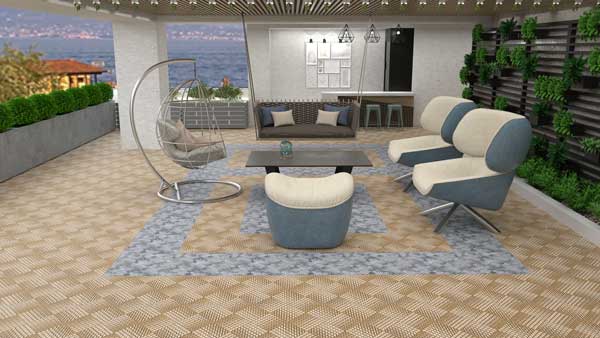How to Mix and Match Designer Tiles for a Stylish Home Look

Strong 8k brings an ultra-HD IPTV experience to your living room and your pocket.
Designer tiles can instantly elevate the aesthetic of any space, providing unique texture, colour, and design that bring character to your home. Whether you’re remodelling your kitchen, bathroom, or even creating an outdoor oasis, mixing and matching designer tiles can result in a stylish, cohesive look that reflects your personal taste.
Here’s a guide to help you get started and create stunning interiors with a blend of tiles like swimming pool tiles, digital tiles, and more.
1. Understand Your Space and Style
Before diving into the world of designer tiles, take time to assess your space and determine the overall style you wish to achieve. Whether you’re going for a modern, rustic, or contemporary look, the choice of tiles should align with the room's purpose. For instance, if you're decorating a poolside area, opting for stylish swimming pool tiles with anti-slip properties can add both beauty and functionality.
Consider the color palette and materials. Neutral tones work well as a backdrop, while bold designer tiles can serve as focal points. Understanding the balance between colors, patterns, and materials is key to mixing tiles effectively.
2. Mixing Different Textures and Finishes
One of the most exciting aspects of designer tiles is the variety of textures and finishes they offer. Combining different textures can add depth and dimension to your space.
For example, you could pair glossy digital tiles with matte wall tiles to create a modern contrast. Glossy tiles like those used in bathroom designs offer a sleek, polished look, while matte finishes provide a soft, understated elegance. Experimenting with textures like natural stone tiles alongside ceramic tiles or glass tiles can give your space a dynamic and visually interesting appeal.
3. Pairing Complementary Patterns and Designs
When mixing tiles, pairing complementary patterns is essential to achieve a balanced look. If you're using patterned tiles, such as bold geometric digital tiles or intricate mosaic tiles, avoid overwhelming the space with excessive pattern mixing.
Opt for larger tiles, such as plain marble or subway tiles, to offset intricate patterns. For instance, a bathroom design with a feature wall of mosaic tiles can be paired with plain subway tiles on the other walls for a clean, modern feel. Similarly, for kitchen backsplashes, combining a vibrant patterned tile with neutral field tiles helps to maintain focus without making the design feel too busy.
4. Using Contrast and Balance
When mixing tiles, balancing contrast is important. High-contrast combinations like black and white tiles or dark and light color schemes can create a striking look, especially in minimalist designs. However, too much contrast can make the space feel disjointed.
To balance this, pair contrasting tiles with neutral colors. For example, if you have a bold black-and-white floor pattern, consider using soft grey tiles on the walls or ceiling to soften the look. Using contrasting tiles with the same material, like matte or polished ceramic tiles, will maintain a sense of cohesion while introducing visual interest.
5. Consider the Size and Scale of Tiles
The size and scale of tiles play a crucial role in achieving a harmonious design. Mixing different tile sizes can add a sense of movement and flow to your space. However, it's important to find a balance to prevent the space from feeling overcrowded.
In larger rooms or open spaces, you can play with different tile sizes for an eclectic look. For instance, large-format tiles can be used for flooring, while smaller designer tiles, such as mosaic or digital tiles, can be used to create feature walls or accent details. In smaller rooms, smaller tiles like 4x4 ceramic tiles or hexagonal tiles might be better suited to avoid overwhelming the space.
6. Creating a Cohesive Theme
A successful tile mix should have a common thread that ties everything together. This could be a shared color scheme, material, or pattern that runs through the design. For example, if you’re decorating your patio area, using similar color tones for outdoor tiles and swimming pool tiles can create a harmonious flow from inside to outside.
You might also consider a theme such as "natural" by pairing wood-look tiles with stone-effect tiles, providing a rustic and organic atmosphere to your living spaces. Similarly, pairing industrial-inspired tiles with sleek modern tiles helps create a contemporary, yet edgy vibe.
7. Adding Accent Tiles for Pop and Focus
One of the easiest ways to mix and match designer tiles is by adding accent tiles. Accent tiles act as a focal point and can be used to highlight specific areas of the room, such as the kitchen backsplash, bathroom shower, or feature wall.
For example, adding a strip of vibrant digital tiles in the middle of a bathroom can break the monotony of neutral tones and create a visual centerpiece. Similarly, in an outdoor space, incorporating colorful or patterned swimming pool tiles around the pool's edge can add character and warmth.
8. Play with Layouts and Arrangements
The way tiles are laid out can drastically change the overall look of the room. Herringbone, chevron, and diagonal layouts add a dynamic touch to otherwise simple designs. For example, laying plain ceramic tiles in a herringbone pattern on the floor can add texture and movement, while a set of geometric digital tiles in a grid pattern can be arranged to create an artful backsplash.
9. Experiment with Tile Borders and Edges
Tile borders and edges can also help define your tile mix. Opting for borders with subtle designs can visually connect different tile types, ensuring a cohesive look. For instance, using a plain tile for the floor and surrounding it with decorative border tiles—like patterned ceramic or mosaic tiles—can add elegance and style.
Mixing and matching designer tiles is all about striking the right balance between texture, color, and pattern. By thoughtfully combining materials like swimming pool tiles, digital tiles, and other designer options, you can create a stylish and unique look for your home. Whether you are designing a modern kitchen, a cozy bathroom, or a luxurious outdoor space, the key lies in achieving harmony while allowing the tiles to complement each other. With the right approach, your space will be transformed into a visually stunning environment that reflects your personal taste and style.
Note: IndiBlogHub features both user-submitted and editorial content. We do not verify third-party contributions. Read our Disclaimer and Privacy Policyfor details.


